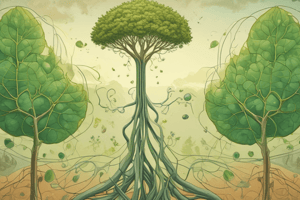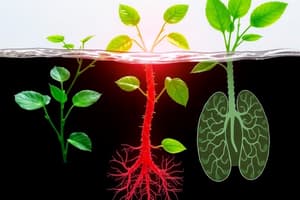Podcast
Questions and Answers
Organisms that cannot make their own organic matter and must obtain it from other organisms are called ______.
Organisms that cannot make their own organic matter and must obtain it from other organisms are called ______.
heterotrophs
The process by which glucose is broken down into two pyruvic acid molecules is called ______.
The process by which glucose is broken down into two pyruvic acid molecules is called ______.
glycolysis
The ______ cycle completes the breakdown of glucose to carbon dioxide.
The ______ cycle completes the breakdown of glucose to carbon dioxide.
citric acid
The ______ chain is the final stage of cellular respiration and generates the majority of ATP.
The ______ chain is the final stage of cellular respiration and generates the majority of ATP.
The process of cellular respiration requires a cell to exchange two ______ with its surroundings.
The process of cellular respiration requires a cell to exchange two ______ with its surroundings.
The first step of glycolysis involves breaking down a 6-carbon glucose molecule into two ______ molecules.
The first step of glycolysis involves breaking down a 6-carbon glucose molecule into two ______ molecules.
During glycolysis, the 3-carbon molecules donate electrons and hydrogen to ______ forming NADH.
During glycolysis, the 3-carbon molecules donate electrons and hydrogen to ______ forming NADH.
The ______ acid cycle is also known as the Krebs cycle.
The ______ acid cycle is also known as the Krebs cycle.
The first step of the citric acid cycle involves the loss of a carbon as ______ from each pyruvic acid molecule.
The first step of the citric acid cycle involves the loss of a carbon as ______ from each pyruvic acid molecule.
In the citric acid cycle, each acetic acid molecule attaches to an enzyme called ______ to form acetyl CoA.
In the citric acid cycle, each acetic acid molecule attaches to an enzyme called ______ to form acetyl CoA.
Flashcards
Autotrophs
Autotrophs
Organisms that produce their own organic matter using carbon dioxide, water, and minerals.
Heterotrophs
Heterotrophs
Organisms that cannot produce their own food and must consume other organisms for nutrients.
Cellular respiration
Cellular respiration
A process where cells exchange gases with their surroundings to produce energy.
Aerobic
Aerobic
Signup and view all the flashcards
Glycolysis
Glycolysis
Signup and view all the flashcards
Citric Acid Cycle
Citric Acid Cycle
Signup and view all the flashcards
Electron Transport Chain
Electron Transport Chain
Signup and view all the flashcards
Steps of Glycolysis
Steps of Glycolysis
Signup and view all the flashcards
Steps of Citric Acid Cycle
Steps of Citric Acid Cycle
Signup and view all the flashcards
NADH
NADH
Signup and view all the flashcards
Study Notes
Autotrophs and Heterotrophs
- Autotrophs are organisms that produce their own organic matter from carbon dioxide, water, and minerals.
- They are also known as producers.
- Heterotrophs cannot produce their own organic matter and must consume other organisms for nutrients and energy.
- They are also known as consumers.
Cellular Respiration
- Cellular respiration is a process that requires a cell to exchange gases with its surroundings.
- Aerobic respiration requires oxygen.
- Cellular respiration generates energy.
Stages of Cellular Respiration
-
Glycolysis:
- Glucose is split into two molecules of pyruvic acid.
- Occurs in the cytoplasm.
- Produces a small amount of ATP.
- Includes three steps:
- 6-carbon glucose is broken into two 3-carbon molecules (requires 2 ATP).
- 3-carbon molecules donate electrons and hydrogen to NAD+, forming NADH.
- Enzymes transfer phosphate groups from 3-carbon molecules to ADP, creating 4 ATP.
-
Citric Acid (Krebs) Cycle:
- Completes the breakdown of glucose to carbon dioxide (waste product).
- Occurs in the mitochondrial matrix.
- Produces a small amount of ATP.
- Includes three steps:
- Each pyruvic acid loses a carbon as carbon dioxide. The remaining 2-carbon molecules are called acetic acid.
- Electrons and hydrogen are transferred to NAD+, creating more NADH.
- Acetic acid combines with coenzyme A to form acetyl CoA, which enters the cycle.
-
Electron Transport Chain:
- NADH combines with oxygen to form water.
- Occurs in the inner mitochondrial membrane (cristae).
- Produces a large amount of ATP.
Studying That Suits You
Use AI to generate personalized quizzes and flashcards to suit your learning preferences.



